Technology and Inclusivity in Music Education
by Marina Gall and the members of the SMS Digitisation Working Group.
Introduction and Context
Throughout my time as a music educator in England, I have been profoundly concerned with social justice and music education, and the question of how to enable everyone to participate in active music making. In 2011, a conversation with a member of the charity Drake Music (n.d.a) made me aware of the exciting new possibilities for disabled students through the use of new technologies and propelled me to a deeper exploration of the topic, both within my research into young people’s use of technology in and out of school, and as lead tutor of the initial teacher education course for secondary music teachers at the University of Bristol, UK.
The following account considers musical learning and disability, particularly – but not exclusively – physical disability, and the opportunities for change that have come about as a result of new technologies. Teacher education courses in England are typically only one year in length but, despite the brevity, we try to include as much consideration as possible of effective ways of teaching and supporting the learning of students with complex disabilities, and discussion of related issues. What follows represents knowledge we attempt to share with our trainee teachers. Whilst there is considerable discussion of the work of the charity Open Up Music, this is not to suggest that it is of most import: it is simply because of the author’s deeper awareness of the work, through her research activity. Furthermore, as might be expected, the focus is on England and the UK, and not on research or professional activities or literature from other countries.
Within the discussion, cultural context is, of course, important. In England, a child of compulsory school age has a learning difficulty or disability if he or she “(1) has a significantly greater difficulty in learning than the majority of others of the same age, or (2) has a disability which prevents or hinders him or her from making use of facilities of a kind generally provided for others of the same age in mainstream schools or mainstream post-16 institutions” (DfE & DoH 2014, pp. 15–16). The, most recent, government policy is explicit in requiring schools to make “reasonable adjustments” (DfE/ DoH, 2014, p.17) to remove barriers, and better support the learning of students with Special Educational Needs / Disabilities SEN/D. Whilst there is a strong move toward inclusivity, parents have the choice as to whether their child attends a mainstream school or whether they are educated in what is called a special school, which caters for students with SEN/D, mainly students with profound and multiple disabilities (PMLD) or whose needs cannot be met within a mainstream setting. Nomenclature is important, since language drives assumptions and beliefs about those with disabilities (Linton, Krcek, Sensui & Spillers, 2014). Terminology differs from country to country, and even within the UK. Whilst Additional Support Needs (ASN) is preferred in Scotland, the term SEN/D – which relates to the most recent English governmental policy – will be used within this account.
The writing is organised under the following sections:
- Technological Developments: New Instruments
- A New Approach to Ensemble Music Making for Students with Disabilities: The Clarion and Open Orchestras
- Research Project Getting Things Changed: (Tackling Disabling Practices: Co-production and Change)
- Opportunities for Progression into the Profession
- Removing Barriers to Progression
- Support for Teachers via Technology
- Final Thoughts
Technological Developments: New Instruments
Drake Music
Drake Music (Drake Music, n.d.a), a charity that has been in existence since 1993, focusses on ways in which new technologies enable practical music making for disabled people. It offers a variety of services to people of all ages, within formal and non-formal settings. Staff, many of whom are disabled themselves, work with partners such as schools and arts organisations to provide inclusive music-making activities for young people. They also offer consultancy and resources, and training for teachers and music leaders. In 2010, Drake Music established the DM Lab: regular meetings are held in which disabled musicians meet with coders and technological developers to experiment and share ideas about new inclusive music technologies (Drake Music, n.d.b). Figure 1 below shows a bespoke guitar created through DM Lab collaborations. Further detail about this innovation, including a video, can be seen at https://www.drakemusic.org/technology/instruments-projects/the-kellycaster/ and their Accessible Musical Instrument Collection and ongoing projects is available at https://www.drakemusic.org/technology/accessible-musical-instrument-collection/.
Research concerning the work of Drake Music include Anderson & Smith (1996), Welch, Purves & Himonides (2006), Watts & Ridley (2007), Samuels (2015) and Himonides (2018). A new study starting in 2022 – considering how disabled DJs adapt their performance strategies and instruments when DJing, and also what disabled DJs need to make DJing more accessible to them – is explained at https://www.drakemusic.org/blog/becky-morris-knight/dj-research-project-with-university-of-birmingham-and-native-instruments/.
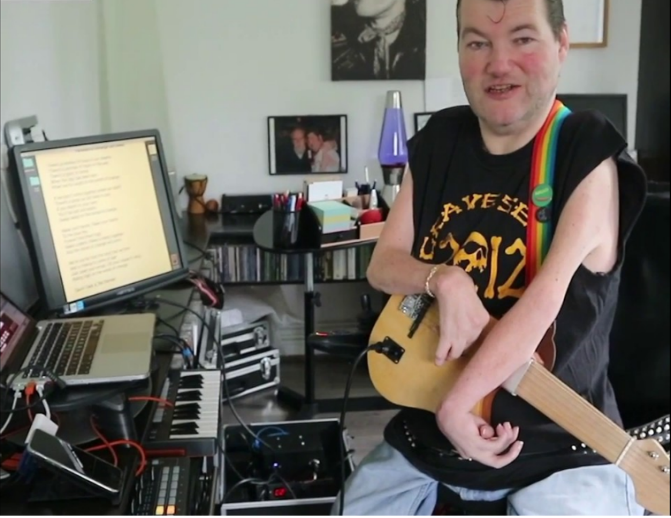
The One Handed Musical Instrument Trust
The One Handed Music Instrument Trust (OHMI, n.d.) is another charity concerned with changes to instruments to promote inclusivity. Aware that many instruments require the use of two hands and/or a fully able body, this charity’s chief focus is the development of new instruments for the disabled. Adapted versions of ‘traditional’ instruments that have been created through their support include a one-handed bass recorder, a saxophone interface that enables a one-handed musician to play a full chromatic scale from Bb below middle C to the E two and a half octaves higher, and a cello stand to enable the instrument to be played with the feet (see Figure 2).

New instruments have also been invented. One example is the linnstrument (see Figure 3). Each of the ‘dots’ are notes, available as semitones, that can be arranged in any way, and also lighted using up to 10 colours.
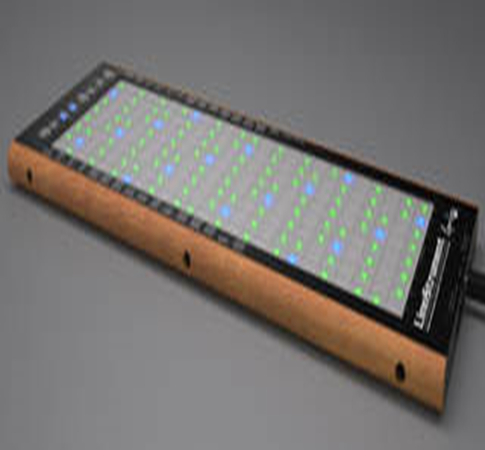
In many cases, instruments must be created to fit the exact requirements of one individual, so many that the OHMI helps to produce are bespoke. However, others are useful to a range of musicians. The trust also provides low-cost hire of certain of these instruments, which is of great benefit to disabled people who can often have financial difficulties. See https://www.ohmi.org.uk/instrument-hire-scheme.html and https://www.ohmi.org.uk/instruments.html for a full list of instruments.
2019 saw the launch of the OHMI Research Partnership: a collaboration between the OHMI Trust, Queen Mary University of London, and Birmingham City University. The partnership focuses on subjects relating to music and disability, including instrument design and adaptation, music education, policy issues and social impact. Presentations from their 2018 conference can be viewed at https://www.ohmi.org.uk/ohmi-conference-presentations.html. A review of an OHMI “Teaching Project” in which 15 children with upper limb disabilities, aged between 7 and 11, engaged in a range of music making activities through the use of specially adapted instruments is available at http://www.ohmirp.org.uk/uploads/1/2/8/1/128186464/ohmi_research_report.pdf.
A New Approach to Ensemble Music Making for Students with Disabilities: The Clarion and Open Orchestras
Another accessible technological musical instrument, which has won numerous awards including one from the OHMI, is called the clarion which runs on all common devices such as iPads and laptops. The process of its creation is documented at https://network.youthmusic.org.uk/posts/clarion-accessible-musical-instrument-8-years-making. The clarion can be played with any part of the body, including the eyes; it is unique in that it can be adapted to suit the needs of individual students.
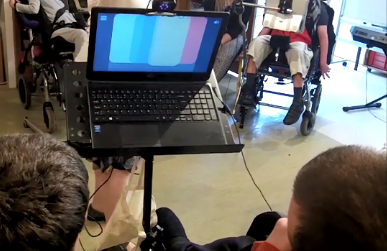
Differing Clarion Interfaces (Photos by Marina Gall) 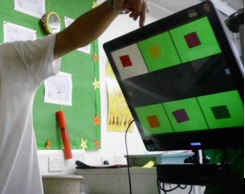
Differing Clarion Interfaces (Photos by Marina Gall)
Figure 4 shows some examples of the programme’s interface. The left screen is a bassline part of Pachelbel’s Canon. Each of the large squares is a musical note, with variability in volume: accessing the low part of the screen (in this instance each square) produces a quiet sound; this gets progressively louder the higher up, in the square the note is played. Having tried playing the clarion myself many a time, (using Eyegaze), I can vouch for the fact that it is really difficult to create a fluent, musical line. I liken this to playing a stringed instrument: positioning one’ eyes to create exactly the right volume is something like placing one’s finger at precisely the correct place on the fingerboard to create the exact pitch required. Short videos giving further explanations of how the clarion works, including students playing the instrument, can be seen at http://openupmusic.org/the-clarion/ and https://vimeo.com/134287553.
Figure 4 also illustrates how it is possible to change the visual representation of the musical notes to suit the physical and intellectual capabilities of the student. On the left, student X’s physical capabilities were such that he had considerable head movement; he also had the intellectual capability to remember patterns. As such, using his eyes (Eyegaze), he was able to move, capably, between the 6 notes that constituted his repetitive ground bass part of Pachelbel’s Canon. Also involved in playing the same piece, the young man on the right, student Y, was only able to make small movements with one arm, thus, he was given fewer notes, larger in size and also overlapping, making these easier to play, physically. He performed using a Smartnav – a small reflective dot (sensor) – placed on the hand of his mobile arm.
The clarion is central to the work of the charity Open Up Music (n.d.). Having spent years working towards removing the barriers to participation in music making by young disabled people (Farrimond et al., 2011), in 2014, the directors founded the charity with the aim of encouraging ensemble (orchestral) music-making by disabled young people. Their first focus was Open Orchestras (Open Up Music, 2020), an approach to ensemble music making for young people in special schools in England. Within this, many students – because of necessity – use the clarion, although other ‘traditional’ instruments, usually percussion, are included according to the students’ interests/ capabilities. An essential aspect of Open Orchestras is the availability of repertoire – adapted versions of pre-existing orchestral music – specifically created for Open Orchestras’ work. A further important element is that support is provided by the charity, enabling teachers to learn about effective pedagogical approaches, as well as to become part of a network of educators who can discuss and share practice. (The video at https://www.openorchestras.org/ tells more about Open Orchestras; at 1 minute, 29 seconds, student Y, discussed above, is playing). The approach has shifted thinking about music making: traditionally, disabled young people have had to adapt to existing instruments and musical repertoire, whereas, with Open Orchestras the musical instruments and repertoire are re-shaped and re-worked around the needs and musical identities of young disabled people.
Research Project: Getting Things Changed: (Tackling Disabling Practices: Co-production and Change)
The research was supported by the UK Economic and Social Science Research Council (ESRC) under grant number ES/M008339/1
Background
Open Orchestras has become the focus of my own research since 2016, the year in which I carried out a pilot study that was to inform the work within a major research project called
Getting Things Changed: (Tackling Disabling Practices: Co-production and Change) (University of Bristol, n.d.). This project was co-produced with disabled people and their organisations, and also included Disability Rights UK as a partner. It considered how changes could be made to practices across a wide range of fields: medical, social and educational. These were: Good conversations with people with dementia: a key to improvement; Personal assistants supporting decisions by people with learning difficulties; People with learning disabilities on TV; Changing academia: disabled students and staff in universities, Reasonable adjustments in hospitals, Successful practices for supporting parents with learning difficulties, User-driven commissioning: disabled people’ organisations and co-production.
Data within the music education work took the form of videoed weekly sessions of Open Orchestras in two special schools for students with profound and multiple learning difficulties (PMLD), and interviews of staff and students who were involved. Two ensembles were studied – one in each school – both of which consisted of 5 students aged between 14 and 21.
Findings: The Importance of Group Music Making
The following quote taken from an interview within the pilot project, with one young person’s father, highlighted the importance of music making to young disabled people, particularly in an ensemble setting:
Z is 15, has cerebral palsy, full body involvement (can’t use any of her body purposefully), can’t speak, is doubly incontinent, has epilepsy and visual impairments. She’s fed through a peg.Music is my daughter’s ‘cup of tea’….when she gets to access music she really comes alive because lots of the time, you can imagine, she’s in a chair, under someone else’s control; they locate her where they think she should be located, to do an activity that they think she might like and she’s got no control over this. And, so, lots of the time it’s not what she wants to do, and she disengages from the world…[in] an extreme form of daydreaming…but music makes her really engaged and fully switches her on. And it’s very important for her to be engaged with the world and switched on and interacting because that will really help her to communicate and emote and make herself heard.
She comes home with her iPad with her clarion on it and that’s what she uses in the orchestra. And the orchestra is very nice because she actually makes music: she’s participating. And she’s in a group so she’s with her peers. And she’s very sociable is X, and so she responds very strongly to peer interaction…She enjoys being creative
anyway, and so anything where she’s making things is very good for her – but music especially, because music is really ‘her thing’ and so opening up access to music making in this way is very important for her and it gives her a great deal of enjoyment, a great deal of happiness.
Findings: New Approaches to Assessment and Accreditation of Work
Within the Getting Things Changed project (University of Bristol, n.d.), a significant finding related to various ways in which student progress was recognised and celebrated. Students with profound or complex additional needs often take a considerable time to master a new skill. As such, the usual school assessment systems are unsuitable since they often mean that disabled students’ capabilities fall into the lowest grades, which is demotivating. However, different systems of assessing were used, to good effect, within the three research schools. The pilot school used a system devised by Adam Ockelford and colleagues, called Sounds of Intent (Ockelford et al., 2011). See Figure 5 below.
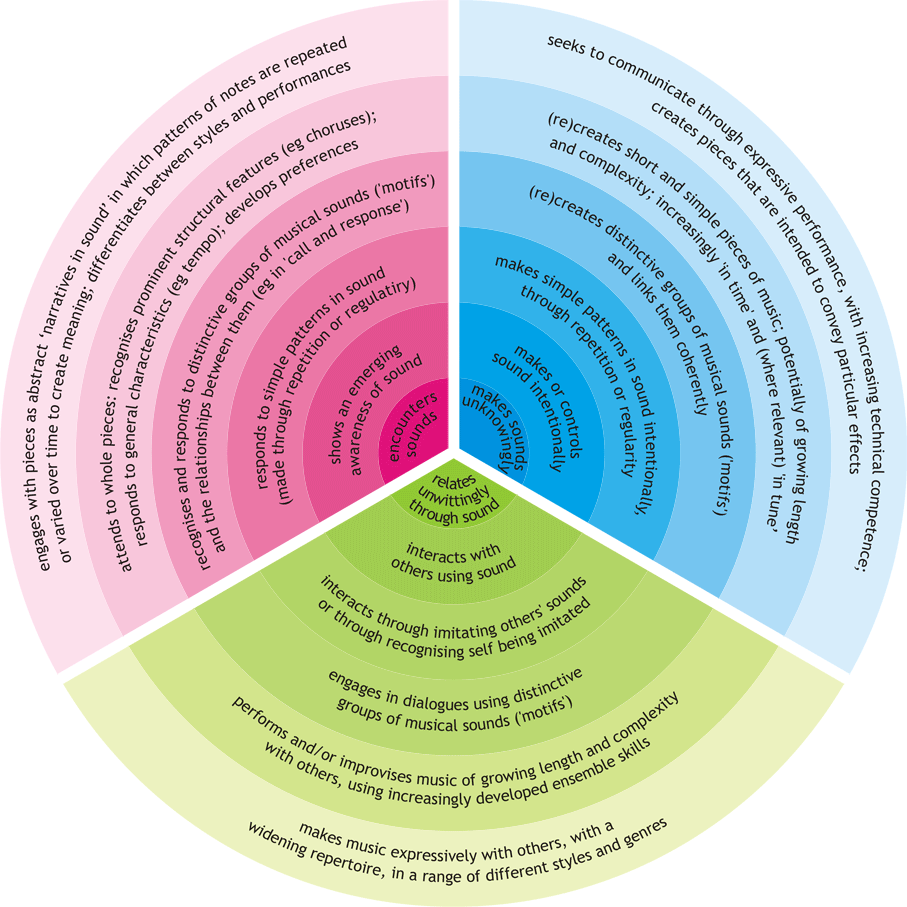
A student’s progress is measured against 3 skills: how they react to music, how proactive they are during musical activities, and now well they interact with others during music making. The teacher uses the criteria in each sphere to map progress (beginning at level 1, in the centre of the circle). This enables a recognition of incremental changes / progress during music making. For more information, see https://www.soundsofintent.org/.
Another of the schools worked towards an Artsmark standard: a creative quality standard for schools and education settings which is accredited by the Arts Council England (Artsmark, 2021). This is a standard applied to a school as a whole. There are three standards: bronze, silver and gold. The school writes a self-assessment, then creates a “statement of commitment” including targets for development; it then ‘delivers’ its goals and submits a statement of impact which is considered before the award is given.
A different ‘alternative’ qualification was the focus within the third school: ASDAN (n.d.). ASDAN is a UK education charity which provides accredited curriculum programmes, and a range of other courses for young people aged 11 to 25 years for whom the usual school qualifications are unsuited. These include programmes and units related to the arts. However, even within ASDAN, the arts and music units were not appropriate for the students because of their profound and multiple disabilities. As such, the young people worked within a unit called Engaging with the World Around You: Events which enabled teachers to map their progress as they prepared for and performed in a concert in Bristol’s largest concert hall. The music leader in this school commented:
…by giving them an ASDAN accreditation, it’s showing them how they’re progressing…the orchestra is helping them academically as well.
The last point was echoed by a speech therapist. She explained that Eyegaze is a highly useful electronic (computer) communication device, common in special schools, yet it is hard to master, and students often give up on it. However, using it within Open Orchestras motivated a number of students to persevere with it and to gain proficiency; this had a positive impact on their other school subjects, as well as their music making.
Other Findings
Perhaps to be expected, a key finding was the significance of the clarion’s ability to change the size, shape and position of the notes on the computer screen; and the fact that it can be played using finger touch, a sensor on a moveable part of the body, or using only the eyes. This enabled students with profound and/or multiple disabilities to participate actively. The research also identified ways in which teaching assistants might support the young people most effectively. Further findings related to the development of students’ self-esteem and notions of identity, and their social growth through ensemble music-making; and to the significance of the opportunities for progression during and after leaving school through the National Open Youth Orchestra (see next section).
Opportunities for Progression into the Profession
National Open Youth Orchestra (NOYO)
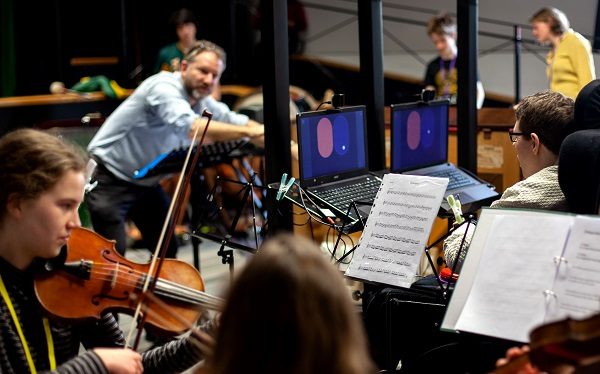
Within the UK, the creation of new technologies has been significant to a move toward inclusivity beyond school. The Open Up Music directors, concerned to offer opportunities for progression for those disabled students motivated to take their music education further, set up the South West Open Orchestras, which drew together interested disabled young people from a variety of schools, to engage in more complex work. In 2016, the orchestra performed a piece composed especially for the ensemble that was also transmitted nationally, on BBC Radio 3, as part of the UK’s BBC Music Day. See https://www.bbc.co.uk/programmes/p03z4pgm for an extract of that exact performance. In 2018, they worked on a new piece for which a young composer then won a British Composer award. The full performance of this can be heard and seen at http://noyo.org.uk/the-orchestra/#section2. The South-West Open Youth Orchestra was a regional pilot for the National Open Youth Orchestra (NOYO) (Open Up Music, 2020), the world’s first disabled-led national youth orchestra, which was launched in 2018 and is currently rehearsing for its first performances in England in 2022 (sadly, postponed in April 2020 as a result of COVID). See the videos at http://noyo.org.uk/were-still-buzzing-from-the-noyo-residential/ for footage of some of the rehearsals for this, and http://noyo.org.uk/apply/ in which performers and their parents talk about the orchestra. This Open Up Music venture is partnered by the London Barbican Arts and Learning Centre, the Guildhall School of Music and Drama Conservatoire and the Bournemouth Symphony Orchestra; such partnerships and concerts have been significant in drawing national attention to the potential of young disabled musicians. Additionally, educators, musicians and audiences have been made aware of the exciting possibilities of the creation of new musics through the inclusion of new instruments such as the clarion. Indeed, a number of composers are now interested in writing music for the Open Orchestras’ ensembles and for the National Open Youth Orchestra.
The British Paraorchestra
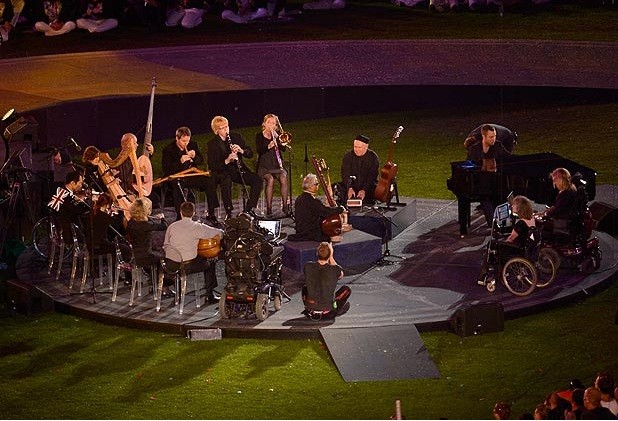
A high-profile event which displayed the capabilities of disabled musicians took place in 2012, when The British Paraorchestra (The Paraorchestra and Friends, 2021) – the world’s first orchestra for disabled musicians – performed at the Olympic Games’ closing ceremony in London, along with the rock group Coldplay (Brown, 2012). The performance can be seen at https://www.youtube.com/watch?v=Pu9CvbGJmss, the majority of players using recently created instruments. In the same year, the orchestra further raised their profile through the release of a single, in conjunction with the Kaos Singing Choir for Deaf and Hearing Children, and athletes from the GB paralympics team. See and hear the music video at https://www.youtube.com/watch?v=bupIH3UkPnU The paraorchestra provides another opportunity for young disabled musicians wishing to take up a career in music and could be seen as one progression route to players from NOYO. Others are beginning to emerge.
Bournemouth Symphony Orchestra (BSO)’s Change Makers programme including Resound
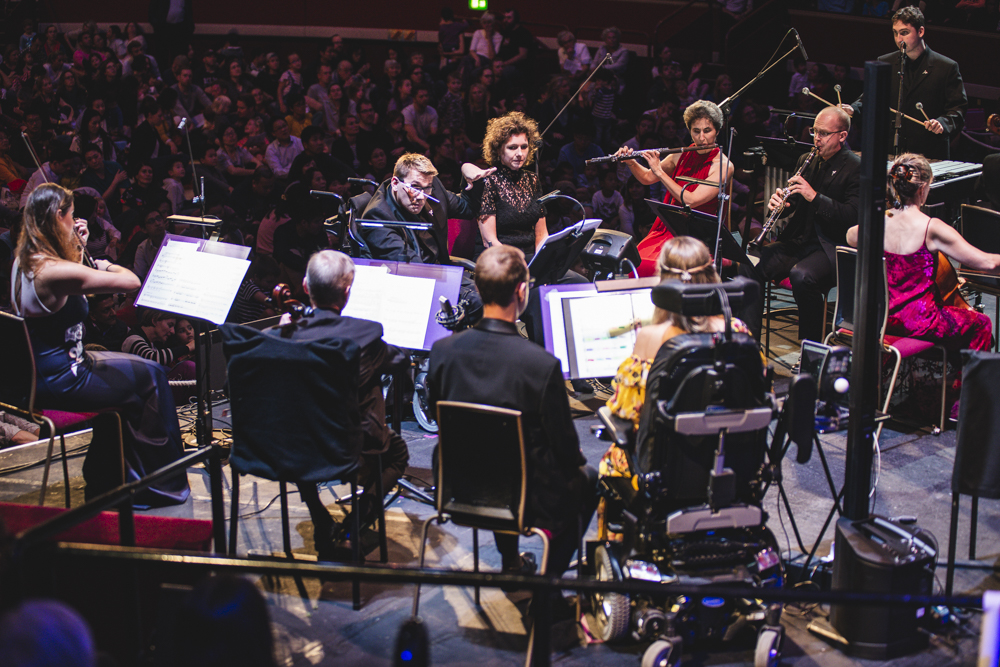
In 2017, the Bournemouth Symphony Orchestra (BSO) developed a (Change Maker’s) programme with three main foci (BSO, n.d). One focus was the creation of Resound, a disabled-led ensemble which was provided with opportunities to give a series of public performances and workshops including at the BBC Proms, a highly celebrated annual event in London’s Albert Hall. Many of these events were given wide media coverage, further displaying the potential creative capabilities of disabled musicians. https://bsolive.com/news/a-year-of-bso-resound/ provides an outline of the work of Resound carried out over a year and includes videos. The ensemble was initiated and conducted by a disabled musician, James Rose who, owing to his physical disabilities, conducts with the baton attached to his head. See https://www.youtube.com/watch?v=SgjfZhkMvCA for a BBC news item which shows James conducting and speaking about his work. The Change Makers programme provided funds to enable James to work for 18 months with Resound, during which time, aside from their own performances, the ensemble also joined the full BSO orchestra to perform works by Shostakovich, Bernstein and Tchaikovsky. The third aspect of the BSO Change Makers programme was the development of an ongoing series of organisational change activities, including training for the whole BSO staff to embed accessibility and disability awareness throughout the organisation.
Removing Barriers to Progression
Whilst James Rose was fortunate in gaining professional performing opportunities without post-school formal music studies, most young people enter the profession or teaching via a university, a music college or a conservatoire and, as present, I am not aware of any in the UK studying a technologically-assisted instrument in a higher education establishment in the UK. This relates back to the points above concerning accreditation: aside from school examinations, instrumental qualifications have yet to be created for such instruments. Charlotte Bott (née White), who now plays the linnstrument in Resound, tells her personal history of how she loved playing music using technology yet, in her youth in the early 2000s, she could not get her competencies accredited through any of the boards that offer examinations in instrumental performing. (The websites https://www.drakemusic.org/experience/charlotte-white-bronze-arts-award/ and https://www.bbc.co.uk/news/health-12810149 include a video of Charlotte as a teenager playing Bach’s Cello Suite no 1 in G major, and links to a thirty-minute BBC programme on her musical pathway to 2011.) Despite this, Charlotte went on to compose music for the Northern Lights Music Festival in Tromso, Norway, but was not able to get to study music in a higher education institution without ‘traditional’ music qualifications. However, she did attend university, gaining a Bachelor’s degree in Social Policy and Criminology and a Master’s in Social Policy. She is now a social worker, a role she combines with her musical ventures: she is part of Resound, has played with the British Paraorchestra, is an Arts Award advisor, and has also acted as music leader for Open Orchestras.
Whilst, as a young person, the lack of opportunities to acquire a place on a higher education music course was, initially, a significant upset to Charlotte she, nevertheless, recognised the strong positive impact that engagement in music through technology had had on her:
Music inspired me in the belief that I could achieve anything…I had much more of a drive and wanted to break the barriers and do the same things as everyone else, rather than just being bracketed as a disabled person.
With two decades having passed since Charlotte experienced these personal setbacks in her aspirations to study Music, it is my hope that we are on the pathway to change so that, in higher education, staff are open to the study of these instruments and the ‘system’ enables this, especially if the person wishing to explore their musicianship through a ‘non-traditional’ instrument is disabled. Furthermore, there are many varied careers in or associated with music that require a degree for entry. Thus, whilst this reflection has, to this point, focussed on performing music, many of the issues related to supporting disabled students to gain entry into, and complete, higher education music courses apply equally to those wishing to learn how to be a music teacher.
Meanwhile, in Bristol, UK, the local music education hub – a collection of organisations, including the local authority, schools, arts organisations, community and voluntary organisations that work together in a local area to create a joined up musical education provision for all children in and out of school – has developed an initiative focussed on inclusivity. In recognition of:
- the fact that it is difficult for a disabled person to gain a place at a university or college music course or an initial teacher education course;
- the numerous opportunities that exists to lead music education work outside of formal educational institutions;
- the need for broader awareness of issues of diversity and inclusivity in music education,
in 2017, the hub created A New Ambition for Inclusive Excellence (BPM, n.d.a). As part of this, a training programme has been established with the National Centre for Inclusive Excellence called The Inclusive Practitioner Certificate of Music Educators (BPM, n.d.b). Within this, musicians develop their awareness of diversity and inclusion, and inclusive music pedagogical skills. It has attracted both disabled and non-disabled musicians, offering opportunities for non-disabled members of the group to gain insights not only from the course leaders, but also from the lived experiences of the disabled participants.
Support for Teachers via Technology
Whilst the focus, thus far, has been on specific music technologies, students participating in the music teacher education course I work on are also introduced to the following web materials which support musical activities with people with SEN/D, in mainstream schools and beyond, and which inform their thinking about issues of inclusivity and music education.
The Royal National Institute of Blind People (RNIB, 2021)
The RNIB offers a wide range of services including many specifically related to music. There is a system for purchasing or loaning music in whichever accessible format best suits the learner: Braille music, Modified Stave Notation (MSN) and audio resources. They also operate a music transcription service. The MSN is useful for a range of additional needs, not only sight-impairment. The fact that it generally enlarges the music and makes a score more consistent, is also useful for people with dyslexia. Additionally specific requests, such as making something larger or bolder are also possible. Other examples of alterations it offers are:
- The thin lines for note tails and the stave can be made thicker, as can slurs.
- Articulation marks can be made much bigger.
- Dynamics are consistently placed below or above the stave.
- Any unusual signs or placing of symbols have a print note to help make sure you do not miss them.
- The music is usually printed in landscape format rather than portrait, to minimize the number of times you need to track back to the beginning of the next line, and so that the top of the page is less far away from your hands, if you are a keyboard player.
- For ensemble scores, such as the vocal line for a choir, rehearsal numbers or letters are made as clear as possible, and in all longer pieces bar numbers are made larger and clearer.
For full details see https://www.rnib.org.uk/information-everyday-living-home-and-leisure-music-reading-music-accessible-formats/modified-stave-notation.
The Short Guide to Accessible Music Education (Lines & Westrup, n.d.)
This award-winning online resource came about as a result of meetings of the UK Music Education Council’s Special Educational Needs Disabilities (ASN/SEND) Group which draws together teachers, teacher educators, managers and researchers to discuss issues related to inclusion. The resource provides information about useful contacts, materials and support across the regions. It is currently in the process of being updated.
Youth Music (NFYM, 2020a)
Youth Music, funded by the Arts Council England, has musical inclusion at the centre of its work. The charity offers a wider range of projects, large as well as small in scale, to engage young people with SEND in music making, and to offer support for those wishing to enter the music profession. One key support document they have created is the publication A Quality Framework for Music Education started in 1999, was later updated to be more inclusive (NFYM, 2016). The framework is a tool to help educators understand, measure and evaluate quality in music making activities, whether they do or do not include technology.
Although, again, not a technology-specific resource, another significant document created by Youth Music’s is Reshape music: A report exploring the lived experience of Disabled musicians in education and beyond (NFYM, 2020b). The report includes the first-ever national survey into Disabled people’s experiences of music education and music-making carried out by a research team, including eight co-researchers who are all Disabled musicians. Whilst this document also does not offer advice on how best to teach disabled students/ supporting their learning, it is hugely important since it sets out the significant barriers faced by Disabled musicians when accessing music education and music-making, and also includes case studies of those who have been successful.
Final Thoughts
Much of this account, despite focussing on technology, has discussed music that is classical in nature. However, it is evident that to be fully inclusive education establishments, at all phases, should offer opportunities for young people to engage in music that motivates them, whatever the genre. The examples I have discussed illustrate the use of new technological instruments such as the clarion and the linnstrument in classical contexts, yet these instruments are equally suited to different types of music: popular, folk, experimental music, non-idiomatic improvisation etc. I believe that, in the future, we may also see and hear them within a diverse range of ensembles.
In 2014, Sutherland et al. wrote wise words: “ICT alone does not enhance learning…how ICT is incorporated into learning activities is what is important…” (p.413). Whilst pedagogical knowledge and skills are essential to the effective integration of technology within learning and teaching, this blog has shown that many disabled children and adults have only been enabled to engage fully in practical music-making because of the creation of new music technologies and instruments. Such innovations not only enrich the lives of individuals but are also significant in helping to change attitudes in society toward diversity and inclusion.
This reflection ends by returning to the Bournemouth Symphony Orchestra’s Change Makers programme and the words of the orchestra’s CEO that express so well the importance of focussing on inclusion:
Putting inclusion at the heart of the orchestra has been transformative. Embracing the small everyday things that over time lead to systemic change has brought us closer to the society which we are here to represent and whose lives we enrich through our music. It has changed the way we look at our Company, our Art, our Audience and our role in the world (BSO, n.d.).
Postscript
If you’ve got to the end of this and missed / not had time for the music video of the single created by the British paraorchestra orchestra with the Kaos Singing Choir for Deaf and Hearing Children and athletes from the GB paralympics team. Do visit https://www.youtube.com/watch?v=bupIH3UkPnU. So uplifting!
References
Adams, M. (2003). Disability Discrimination Act Part IV: One Year On, Inclusion: a focus on disability and widening participation in higher education. Action on Access and the National Disability Team, 1, 26-7.
Anderson, T. & Smith C. (1996). “Composability”: widening participation in music making for people with disabilities via music software and controller solutions. Assets 1996: Proceedings of the Second Association for Computing Machinery (ACM) Conference on Assistive Technologies, 110-116. https://dl.acm.org/doi/10.1145/228347.228365 (Accessed 12 November 2021).
Artsmark (2021). Artsmark. https://www.artsmark.org.uk/about-artsmark (Accessed 12 November 2021).
ASDAN (2016). SEND Provision. https://www.asdan.org.uk/send-provision/
(Accessed 12 November 2021).
Brown, M. (2012). Coldplay join the paraorchestra of disabled musicians for closing ceremony. The Guardian, 1 September. https://www.theguardian.com/society/2012/sep/01/orchestra-disabled-people-play-paralympics (Accessed 12 November 2021).
BPM (Bristol Plays Music) (n.d.a). A New Ambition for Inclusive Excellence. https://www.bristolplaysmusic.org/news/bristol-music-trust/new-partnership-boosts-inclusive-music-making-city/ (Accessed 12 November 2021).
BPM (Bristol Plays Music) (n.d.b). Workforce. https://bristolplaysmusic.org/a-new-ambition/workforce/ (Accessed 1 November 2021).
BSO (Bournemouth Symphony Orchestra) (n.d.). (Rising Talent) Change Makers. https://bsolive.com/projects/change-makers/ (Accessed 12 November 2021).
Drake Music (n.d.a). Drake Music: Leaders in Music, Disability and Technology. http://www.drakemusic.org (Accessed 12 November 2021).
Drake Music (n.d.b). Technology. https://www.drakemusic.org/technology/ (Accessed 12 November 2021).
Farrimond, B. (2016). The Clarion – an accessible musical instrument 8 years in the making. https://network.youthmusic.org.uk/posts/clarion-accessible-musical-instrument-8-years-making. (Accessed 12 November 2021).
Farrimond, B, Gillard, D., Bott, D. & Lonie, D. (2011). Engagement with Technology in Educational and Disabled Music Settings. https://network.youthmusic.org.uk/file/5694/download?token=I-1K0qhQ (Accessed 1 November 2021).
Gall, M. (2017). Special Educational Needs / Disability: Innovations and Innovative Practices in Music Education and Music Teacher Education. In R. Girdzijauskiene & M. Stakelum (eds.), European Perspective on Music Education: Creativity and Innovation. Innsbruck: Helbling, pp.165-181.
Gall, M., Williams, V. & Webb, J. (forthcoming) Technology and Change: Open Orchestras for Young People with Special Educational Needs/ Disabilities.
Himonides, E. (2018). The Mis-understanding of Music-Technology Education: A Meta Perspective. In G.E. McPherson & G.F. Welch (eds.) Creativities, Technologies and Media in Music Learning and Teaching (An Oxford Handbook of Music Education). Oxford / New York: Oxford University Press, pp.119-142.
Lines, E. & Westrup, J. (n.d). The Short Guide to Accessible Music. https://theshortguidetoaccessiblemusiceducation.wordpress.com/ (Accessed 12 November 2021).
Linton, K.F., Krcek, T. E., Sensui, L.M., & Spillers, J.L. (2014). Opinions of people who self-identify with Autism and Asperger’s on DSM-5 criteria. Research on Social Work Practice, 24(1), 67-77.
NFYM (National Foundation for Youth Music) (2020a). About us.
https://youthmusic.org.uk/about-us. (Accessed 12 November 2021).
NFYM (National Foundation for Youth Music) (2020b). Reshape Music: A Report Exploring the Lived Experience of Disabled Musicians in Education and Beyond. https://youthmusic.org.uk/reshape-music (Accessed 12 November 2021).
NFYM (National Foundation for Youth Music) (2016). A Quality Framework for Music
Education.
https://network.youthmusic.org.uk//posts/new-version-youth-musics-quality-framework-use-send-settings (Accessed 12 November 2021).
Ockelford, A., Welch, G., Jewell-Gorec, L., Chengb, E., Vogiatzogloua, A. & Himonides, E. (2011). Sounds of intent, phase 2: gauging the music development of children with complex needs, European Journal of Special Needs Education, 26(2), pp.177–199.
OHMI (One Handed Musical Instrument Trust) (n.d.). OHMI:Music-making for People with Physical Disabilities. https://www.ohmi.org.uk/ (Accessed 12 November 2021).
Open Up Music (2021). National Open Youth Orchestra. http://noyo.org.uk/ (Accessed 12 November 2021).
Open Up Music (2020). Open Orchestras. https://www.openorchestras.org/ (Accessed 12 November 2021).
Open Up Music (n.d). Open Up Music. http://openupmusic.org/ (Accessed 12 November 2021).
RNIB (Royal National Institute of Blind People) (2021). Music.
https://www.rnib.org.uk/information-everyday-living-home-and-leisure/music
(Accessed 12 November 2021).
Samuels, K. (2015). The Meanings in Making: Openness, Technology and Inclusive Music Practices for People with Disabilities. Leonardo Music Journal, 25, 25-29.
Speakers’ Corner (2021). Charles Hazelwood and the British Paraorchestra Release Christmas Single. https://www.speakerscorner.co.uk/blog/charles-hazlewood-and-the-british-paraorchestra-release-christmas-single (Accessed 12 November 2021).
Sutherland, R., Armstrong, V., Barnes, S., Brawn, R., Breeze, N., Gall, M., Matthewman, S., Olivero, F., Taylor, A., Triggs, P., Wishart, J. & John, P. (2004). Transforming teaching and learning: Embedding ICT into everyday classroom practices. Journal of Computer Assisted Learning, 20(6), 413-425.
The Paraorchestra and Friends (2021). Reinventing the Orchestra for the 21st Century. http://paraorchestra.com/ (Accessed 12 November 2021).
University of Bristol (n.d). Getting Things Changed: (Tackling Disabling Practices: Co-production and Change). http://www.bristol.ac.uk/sps/gettingthingschanged/ (Accessed 12 November 2021).
Watts, M. & Ridley, B. (2007). Evaluating musical dis/abilities: operationalizing the capability approach. International Journal of Research & Method in Education, 30(2), 149-162, Also available at https://doi.org/10.1080/174 (Accessed 12 November 2021).
Welch, G.F., Purves, R. & Himonides, E. (2006). The Drake/Youth Music ‘Plug IT’ Project A Research Evaluation. London: Institute of Education. https://d1wqtxts1xzle7.cloudfront.net/42616767/The_DrakeYouth_Music_Plug.IT_Project_A_R20160212-19862-8pdskn.pdf?1455291598=&response-content-disposition=inline%3B+filename%3DThe_Drake_Youth_MusicPlug_ITproject_a_re.pdf&Expires=1640119666&Signature=PirG1gsYKqzUqikZYScTDDOHqpgI~mIhSf46dfsIZNlz8Z33D45EIy3EO-vyw4AiXSigQBAq0l~0c~EjDSevJNrzTqCEyZ2WvFPzIokUbFkHLRL9VfMcH-Xc5-xzvlKJCuDXqyseKukcUqWFd-aXvdJqlZaOYWvSECv8oZ3UFRXXF1Xz-nTftlxaCsngFkH7~QbvJP95ZkAzxD48xDSnVNkysj0xi82N-yaMRLGLf3YX1w~PJmgjcaa67bvsG4O4i50hJxYEl-Xc3pzb6bMaIazEy-0~wPlPlySmbxrOtfLrRPwpw2dNeJVKwEDKm6B-C~vpTgrwb9EOq2GnqSQmxg__&Key-Pair-Id=APKAJLOHF5GGSLRBV4ZA (Accessed 12 November 2021).